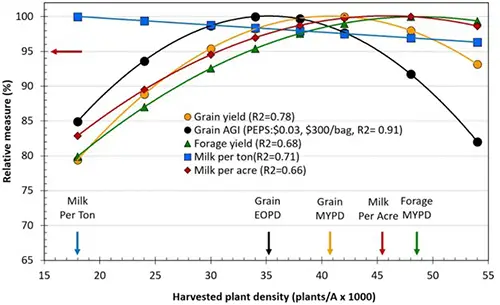
Plant density for silage production
 By Luiz Ferraretto, Ph.D., University of Wisconsin-Madison, Department of Animal & Dairy Sciences, ruminant nutrition extension specialist
By Luiz Ferraretto, Ph.D., University of Wisconsin-Madison, Department of Animal & Dairy Sciences, ruminant nutrition extension specialistForage needs vary vastly within and among dairies across years. Implementation of practices targeting greater yields is key; however, finding the sweet spot between yield and nutritive value is no simple task, especially when producing silage with high fiber digestibility.
Overall, practices focused on the improvement of fiber digestibility of corn plants are associated with yield drags. For example, increasing chop height increases fiber digestibility by leaving more indigestible material in the field. Corn hybrids proven to be more digestible, such as brown midrib (BMR), produce less tonnage per acre.
Increasing plant density is a useful strategy to improve yield and reach required forage inventories. Plant densities have increased in the last 30 years with innovations in technology, management practices and plant genetics.
What is the ideal plant density for silage production? This answer undoubtedly changes for each farm and probably for separate fields within a farm. However, a summary of multiple studies conducted at the University of Wisconsin-Madison (Figure 1) may help us navigate through potential answers.
This analysis revealed currently used commercial plant densities are lower than the predicted for maximum silage or grain yield, but similar to the economic optimum, which, for this study was approximately 35,000 plants per acre. Also, milk per ton, a well-known metric for silage nutritive value, decreases as plant population increases, indicating worse forage nutritive value. But all tested densities had nutritive value within 95% of the maximum.
This effect of plant density on nutritive value is variable in the literature with a reduction in nutritive value reported in some studies but with no effects in others. For example, in 2016 we conducted a study at the UW-Madison Arlington Research Station to evaluate four plant populations (26,000, 32,000, 38,000 and 44,000 plants per acre). Except for a reduction in crude protein concentration, minor effects on nutritive value were observed (Table 1).
Table 1. Effect of plant density on yield and nutritive value of whole-plant corn forage. Adapted from Ferraretto et al., 2017; ADSA abstract.
| Item | 26K | 32K | 36K | 44K | P-value |
| Crude Protein, % DM | 8.0a | 7.5b | 7.7b | 7.5b | 0.001 |
| NDF, % DM | 35.7 | 35.6 | 35.5 | 36.1 | 0.89 |
| Lignin, % DM | 3.5 | 3.4 | 3.4 | 3.5 | 0.38 |
| ivNDFD, % NDF | 50.5 | 51.4 | 51.7 | 50.9 | 0.09 |
| uNDF, DM | 11.6 | 11.3 | 11.3 | 11.6 | 0.51 |
| Starch, % DM | 38.6 | 40.1 | 40.2 | 39.5 | 0.46 |
| ivSD, % starch | 54.2 | 55.7 | 55.9 | 55.7 | 0.14 |
| Yield of DM, ton/acre | 8.0c | 8.4b | 8.8a | 8.9a | 0.001 |
| Milk per ton, lb/ton | 2,806 | 2,815 | 2,813 | 2,779 | 0.55 |
| Milk per acre, lb/acre | 22,257b | 23,564a | 24,662a | 24,529a | 0.001 |
This variation hints some differences across trials may play a major role on the establishment of plant density guidelines, such as soil type and texture, environment, agronomic practices, plant genetics, and degree of plant stressors.
In 2016 and 2017, we conducted a study in northern Florida evaluating two plant densities (26,000 and 30,000 plants per acre), three hybrids varying in relative maturity (118, 124 and 130 days) and different seasons (spring and summer). Increasing plant density improved yield by 10% without compromising nutritive value in the spring, but not in the summer. Overall, research supports greater yields at the expense of minor drawbacks in nutritive value with increasing plant densities.
Because each farm has unique challenges for forage production, testing plant density under its conditions is a nice first step. As suggest by UW Agronomy Professor Joe Lauer, planting two or three rounds of a chosen field with 10% greater plant density than the current density allows for assessment of plant characteristics (i.e., tillering, ear size and fill, lodging) throughout the growing season and yield and nutrient analysis at harvest. A brainstorming meeting between farmer, crop consultant, agronomist, and nutritionist to streamline this test and implementation of new plant density is advised.
Figure 1. Optimum plant density for corn grain yield, economic optimum (AGI), corn forage yield, milk per ton and milk per acre (Source: Lauer, 2019).

| Category: |
Feed quality and nutrition Forage Foundations Forage harvesting Silages |

